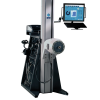
The Ultimate Tennis Exercises Guide for Strength, Performance and Injury Prevention
Treatment GuidelinesMaster your tennis performance with these expert-approved tennis exercises. Build strength, improve agility, and stay injury-free with these proven workouts.
Whether you’re playing for your high school tennis team, a professional, or just a casual Saturday morning player, injury prevention and performance should be on the top of your mind. To this end, every tennis player needs to implement an exercise program which compliments their sport.
Exercise programs centered around injury prevention and performance for tennis can range in complexity. Some people may elect to workout at home, simply using bands and a set of free weights. Others may seek more advanced athletic training equipment, such as the PrimusRS, to take their game to the next level.
Regardless of your goals, ability level, or any other factors, this guide is geared toward helping you achieve better injury resilience and improved performance on the tennis court.
Dynamic Warm-Ups to Prep for the Court
Much like a car (at least the cars of the olden days) needs time to warm up in the morning before taking it for a spin, your body needs time to adjust to the demands of each tennis session. The best way to acutely prepare your body for the upcoming tennis lesson, match, or practice is to complete a comprehensive dynamic warm-up.
There are tons of different ways to design a dynamic warm-up, so do what works for you. Below, I’ll outline a sample tennis dynamic warm-up. The general principles to keep in mind are that the warm-up should progress from general to specific, and from lower intensity to higher intensity.
- Walking high knees across the length of the court x2.
- Arm circles x10 forward and backward.
- Trunk twists x10 each direction.
- Slow jog across the length of court x3.
- Jump rope (or hop in place) x50.
- Faster jog across length of court x4.
- Side shuffle across length of court x2.
- Jog forward, backpedal backward across length of court x5.
Strength and Power Exercises for Tennis Players
Tennis requires significant power production capability. Specifically, the legs, core, and shoulders should all be trained with a plyometric focus in order to best improve tennis performance. Below are some of the best exercises for tennis players to build strength and power:
- Squat Jumps. Squatting trains numerous muscles of the lower body, namely the quads, glutes, and calves as the primary movers. By adding in a jump at the top of the squat, this move becomes a terrific power exercise to enable more explosive movement on the court.
- Lateral Bounds. Often, a tennis player will have to quickly change direction and move laterally across the court. Training lateral bounds helps the tennis player develop quickness in order to get to those tough balls they might ordinarily miss.
- T-Rotation Planks. Planks are a great way to train the abdominals isometrically. However, tennis requires dynamic abdominal and core strength. Adding in a “T” rotation to the plank movement allows the tennis player to strengthen their rotational ability while also targeting many of the primary muscles of the core.
- 3-Way Lunges. Lunges improve single leg strength, balance, and even flexibility (when performed correctly). Single limb strength is important for tennis players who have to frequently bear weight through one leg while transitioning between shots.
Agility and Speed Drills for On-Court Performance
Quickly transitioning from one shot to the next is a key component of tennis, especially for more advanced players. Training agility and speed is a must if one wants to improve their tennis game.
- Sprint to Backpedal. One of the most fundamental parts of an exciting tennis match is when a player can charge the net for a shot, then quickly backpedal to recover for the next shot. These volleys are only possible when the tennis player deliberately trains these moves, through drills such as the sprint to backpedal.
- Cone Drills. Cone drills come in many different varieties. When it comes down to it, you can make up your own cone drill, or you can find one online that you like. As long as you’re quickly moving and changing direction, you will build up your agility and speed.
- Ladder Work. An agility ladder is a good investment if you are a serious tennis player. However, if you have a good, flat piece of concrete available to you (and some chalk or tape), you can make your own agility ladder for just a few bucks. Much like cone drills, there are hundreds of different ladder drills, and they all help to address agility.
Injury Prevention and Mobility Workouts
While some injuries are unavoidable, it is always best to prevent them, if possible. Rehab protocols are long and arduous. Plus, you’re prevented from playing the sport you love while you’re laid up.
By working on your mobility, joint stability, and generally practicing good injury prevention strategies, you can increase the likelihood of remaining healthy throughout your tennis career.
General areas to focus on are the wrists, shoulders, ankles, and surrounding joints/tissues. Below are some starter exercises toward this end.
- Y’s, T’s, and I’s. For a healthy rotator cuff specifically, and a healthy shoulder in general, the alphabet routine is a must. These can be done in prone or standing and you can elect to use bands, dumbbells, cables, or another implement as desired.
- Balance on BOSU Ball. By simply standing on a BOSU ball (on either side), you can significantly improve your ankle health. Once you start incorporating dynamic movements while standing on the ball, you’ll really challenge your ankles and improve their resilience.
- Dynamic Mobility Workouts. Whether you prefer to do a yoga flow or your own mobility routine, you should be performing some dynamic mobility work. This is a great way to hit many birds with one stone by stretching out many of the tissues of your body with just a few dynamic movements.
At-Home Bodyweight Tennis Workouts
One of the issues that many tennis players run into is the belief that they need a high-tech facility for their workouts. For centuries, athletes trained with whatever they had available at home, such as lifting rocks, swinging hammers, and performing good old-fashioned push ups.
Home workouts are a great way to develop a consistent routine. Best of all, you can get a great tennis workout at home without any equipment at all.
- Squats. As was mentioned previously, squats are a key athletic movement. When using your bodyweight, initially focus on slow, controlled motion. Then, as time goes by, add in some explosive power.
- Pushups. Pushups should be included in every exercise plan. They are excellent for building shoulder, tricep, and chest strength. Plus, they stretch out the wrists, which can get quite stiff on a tennis player.
- Sit ups. The abs are critical for tennis players’ success. Strong abs (including the obliques) allow for better power and control during all parts of a tennis match (and for every activity in life).
Using Sports Physical Therapy Equipment for Tennis Rehab and Functional Training
While home workouts, as covered in the last section, can go a long way for all levels of tennis experience and skill, sports physical therapy equipment can help to identify and address specific issues. The PrimusRS is one such example of this equipment.
The PrimusRS provides adaptive resistance and allows for a multiplanar approach to strength training. This aligns better with the functional demands of tennis when compared to most forms of strict dumbbell or band resistance training. These features are extremely helpful for tennis injury rehab and prehab.
Elevate Your Tennis Game with Targeted Training and Rehab
Tennis is a very demanding sport that is not for the faint of heart. If you want to take your game to the next level, while keeping yourself healthy, consider adding in some extra workouts outside of your practice and games.
If you want to see what technology can offer you and your tennis game, check out the products BTE has to offer today.






